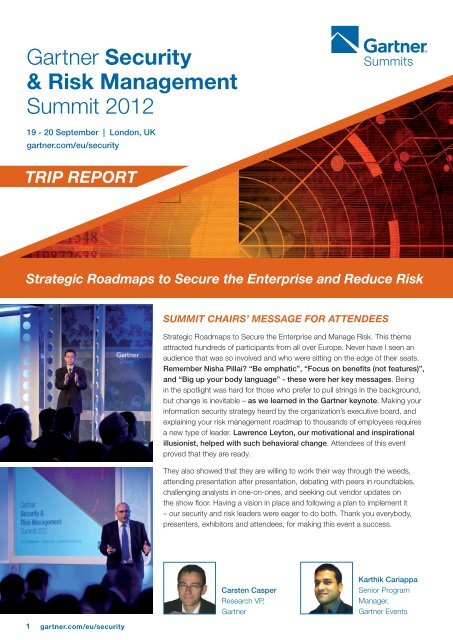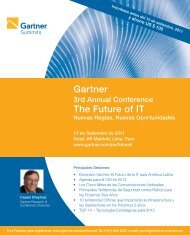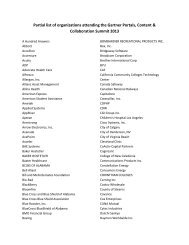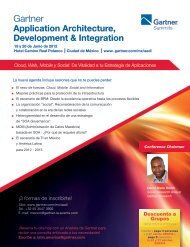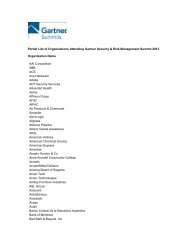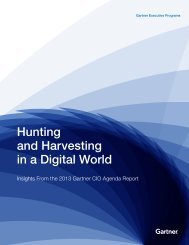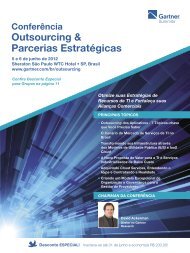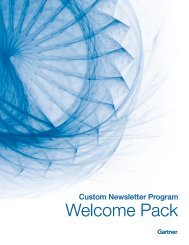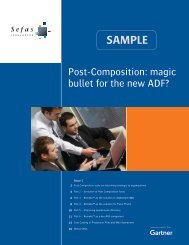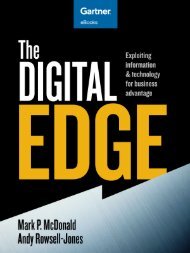Gartner Security & Risk Management Summit 2012
Gartner Security & Risk Management Summit 2012
Gartner Security & Risk Management Summit 2012
Create successful ePaper yourself
Turn your PDF publications into a flip-book with our unique Google optimized e-Paper software.
<strong>Gartner</strong> <strong>Security</strong><br />
& <strong>Risk</strong> <strong>Management</strong><br />
<strong>Summit</strong> <strong>2012</strong><br />
19 - 20 September | London, UK<br />
gartner.com/eu/security<br />
TRIP REPORT<br />
Strategic Roadmaps to Secure the Enterprise and Reduce <strong>Risk</strong><br />
SUMMIT CHAIRS’ MESSAGE FOR ATTENDEES<br />
Strategic Roadmaps to Secure the Enterprise and Manage <strong>Risk</strong>. This theme<br />
attracted hundreds of participants from all over Europe. Never have I seen an<br />
audience that was so involved and who were sitting on the edge of their seats.<br />
Remember Nisha Pillai “Be emphatic”, “Focus on benefits (not features)”,<br />
and “Big up your body language” - these were her key messages. Being<br />
in the spotlight was hard for those who prefer to pull strings in the background,<br />
but change is inevitable – as we learned in the <strong>Gartner</strong> keynote. Making your<br />
information security strategy heard by the organization’s executive board, and<br />
explaining your risk management roadmap to thousands of employees requires<br />
a new type of leader. Lawrence Leyton, our motivational and inspirational<br />
illusionist, helped with such behavioral change. Attendees of this event<br />
proved that they are ready.<br />
They also showed that they are willing to work their way through the weeds,<br />
attending presentation after presentation, debating with peers in roundtables,<br />
challenging analysts in one-on-ones, and seeking out vendor updates on<br />
the show floor. Having a vision in place and following a plan to implement it<br />
– our security and risk leaders were eager to do both. Thank you everybody,<br />
presenters, exhibitors and attendees, for making this event a success.<br />
Carsten Casper<br />
Research VP,<br />
<strong>Gartner</strong><br />
Karthik Cariappa<br />
Senior Program<br />
Manager,<br />
<strong>Gartner</strong> Events<br />
1 gartner.com/eu/security
the audience<br />
The <strong>Summit</strong> attracted over 450 attendees, from 30<br />
countries including 19 European nations represented.<br />
The core of the audience was naturally from the UK, with<br />
the next highest groupings coming from Germany, Austria<br />
and Switzerland followed by Benelux, Nordic, France and<br />
the Middle East. In terms of industries represented the<br />
key sectors were government and public sector, financial<br />
services and manufacturing with a range of other sectors<br />
then present. The best represented job titles continued to<br />
be Director / Manager of Information <strong>Security</strong> / <strong>Security</strong><br />
and variations there of with a presence from <strong>Risk</strong>,<br />
Compliance, and <strong>Security</strong> Architects.<br />
In <strong>2012</strong> the <strong>Summit</strong> brought together over 450 attendees<br />
to learn from and network with a range of end users<br />
giving case studies, key solution providers on the<br />
showfloor and in sessions, and with the <strong>Gartner</strong> analyst<br />
community. Led by the <strong>Summit</strong> Chair, Carsten Casper<br />
the <strong>Summit</strong> took in over 40 presentations, roundtables<br />
and workshops furnishing attendees with the latest<br />
thinking on their strategy, tactical approaches, and key<br />
needs for <strong>2012</strong>-13.<br />
“<br />
Very interesting conferences<br />
showing us how to develop and<br />
increase security in the company<br />
and to have a good view of<br />
evolution of technologies.<br />
”<br />
Directeur Technique, Imsnetwords<br />
Plan ahead for 2013<br />
<strong>Gartner</strong> <strong>Security</strong> & <strong>Risk</strong> <strong>Management</strong> <strong>Summit</strong> 2013<br />
18 - 20 September<br />
London, UK<br />
2 gartner.com/eu/security
KEYNOTE KEY MESSAGE<br />
Guest Keynote:<br />
The Winning Mindset:<br />
Self-Motivation, Influence<br />
and Being Fearless!<br />
The brave will die – The cautious never live!<br />
‘Fear of Failure’, makes people scared to even try<br />
new things just in case they fail, so they don’t even<br />
bother to try as failure for them = pain. So they move<br />
away from the possible pain of failure. It’s time to be<br />
brave and you will achieve your goals…<br />
Be Careful what you say to yourself!<br />
So many times our own self-destructive internal<br />
dialogue can literally talk ourselves into negatives<br />
states of mind, so be careful what you say to<br />
yourself. Remember we are actually in control of<br />
all of this self-talk and therefore we have the ability<br />
to change it. Become aware of it so that you can<br />
change it to something that is useful.<br />
Focus on what you want rather than what you<br />
don’t want!<br />
If I say don’t think of an elephant, what do you do<br />
The mind can’t process negatives, so if you focus on<br />
the wrong things then you end up with them! I don’t<br />
want to fail - you end up focusing on failure!<br />
So remember to focus on what you want rather than<br />
what you don’t want.<br />
Go to the mind movies!<br />
Your mind movies that you play in your head control<br />
how you feel. Once you understand that you control<br />
that then you can learn to play different movies inside<br />
your head and ultimately change the way you feel.<br />
So go to the mind movies and make sure you chose<br />
a good movie!<br />
Getting Your Message Across<br />
Nisha Pillai, BBC World News Anchor<br />
In her keynote ‘Getting Your Message Across’, former<br />
BBC World new presenter, Nisha Pillai shared three simple<br />
but effective tips to aid effective communication, and above<br />
all boost personal authority.<br />
With the aid of videos and on-the-spot exercises the<br />
audience was encouraged to:<br />
• Be emphatic – in the style of Steve Jobs<br />
• Focus on impact, not features – in the style of CISCO<br />
boss, John Chambers, and<br />
• Boost their presence – in the style of Steve Ballmer.<br />
It was a hugely interactive keynote which saw all<br />
the conference delegates up on their feet and<br />
COMMUNICATING in a matter of minutes. There were lots<br />
of laughs and lots of learning too.<br />
3 gartner.com/eu/security
KEY TAKEAWAYS FROM THE GARTNER<br />
SECURITY AND RISK MANAGEMENT SUMMIT<br />
Road Stories: Lessons Learned (and Fingers<br />
Burned) in IT <strong>Risk</strong> <strong>Management</strong> Practice.<br />
Tom Scholtz, VP Distinguished Analyst<br />
• <strong>Risk</strong> management is more an art than a science. An<br />
individual’s experiences, values and goals have a<br />
significant impact on the way he or she interprets and<br />
accepts different risks. <strong>Risk</strong> appetite is a personality trait<br />
that differs widely between people.<br />
• The best way to learn risk management is to practice<br />
it. And the risk management approach must suit the<br />
culture of the organization. Focus on continuous<br />
improvement in risk management practice, gained<br />
through experience.<br />
• The term “risk manager” is arguably a misnomer. <strong>Risk</strong><br />
managers usually fulfill more of an advisory function.<br />
Road Maps to the Next Generation of Firewalls<br />
and IPS<br />
Dionisio Zumerle, Principal Research Analyst<br />
Recommendations:-<br />
Advances in infrastructure protection technology continue<br />
to be primarily reactive to keep pace with new threats. New<br />
threats bring newer features into existing safeguards, rather<br />
than many new protection technologies.<br />
An NGFW is a wire-speed integrated network platform that<br />
performs deep inspection of traffic and blocking of attacks.<br />
A next-generation IPS indicates the necessary evolution of<br />
network IPS to deal with changes in both the way business<br />
processes use IT and the ways attacks try to compromise<br />
business systems.<br />
Changing threat conditions and changing business and IT<br />
processes will drive network security managers to look for<br />
NGFW capabilities at their refresh cycle. The key for NGFW<br />
vendors will be to demonstrate first-generation firewall and<br />
IPS features while including NGFW capabilities.<br />
What the new EU privacy legislation means for<br />
your organization<br />
Carsten Casper, Research VP<br />
Our analyst user roundtable on privacy in Europe was<br />
„sold out“. Discussion topics in the group reflected the<br />
discussions that <strong>Gartner</strong> had with European clients in <strong>2012</strong>.<br />
First, is the new EU data protection regulation a course<br />
correction or a tide change Either way, attendees agreed<br />
that having a privacy management program in place is the<br />
best preparation for any new legislation, whether it hits<br />
us in 2015 like this new regulation or now in <strong>2012</strong> like the<br />
infamous EU cookie rules - which was the second major<br />
topic of the day. In addition to the UK, now also the<br />
Netherlands are getting more active with the enforcement<br />
of these rules that are unclear and burdensome for<br />
most, with little value for the consumer. Know what sort<br />
of cookie your sites use, and document well, but don’t<br />
panic, was the agreed opinion of the group. Pay attention<br />
to tracking techniques in general, not cookies in particular,<br />
if you want to display a good approach to privacy.<br />
How to Run, Grow and Transform Your<br />
<strong>Security</strong> Program<br />
Paul Proctor, VP Distinguished Analyst<br />
Recommendations:-<br />
There is no such thing as perfect protection, but boards<br />
of directors and senior executives expect defensible<br />
assurances that their information and business operations<br />
are sufficiently protected. The answer lies in a set of risk<br />
control programs that are proactive, transparent, riskbased,<br />
measurable and process-oriented. Creating and<br />
formalizing these programs are relatively inexpensive, but<br />
developing mature programs requires high-level support,<br />
a strategic approach and adequate time to execute.<br />
Modern enterprises must also transform their programs<br />
to align with business need and address evolving cultural<br />
gaps between IT and the business.<br />
<strong>Security</strong> and risk management is ready to mature and<br />
become a responsible and critical part of the business.<br />
Board members and executives are asking for more<br />
detailed reports on security and risk management.<br />
The business — not IT — is taking the lead on some<br />
roles, such as business continuity management (BCM),<br />
governance and policy. Business and IT leaders need to<br />
think about security and risk management investments in<br />
new ways.<br />
• Run: Establish and run your risk program. This<br />
category represents the activities and investments<br />
directed toward the maintenance and operation of the<br />
current program, exclusive of IT operational elements.<br />
This would include program management, strategy,<br />
budgeting, process catalog, metrics and dashboards,<br />
policies, compliance, and oversight.<br />
• Grow: Mature your program. This category<br />
represents the activities and investments directed<br />
toward assessing and maturing the program. This<br />
would include program maturity assessments,<br />
the identification of gaps and opportunities for<br />
improvement, and all subsequent activities and<br />
projects to address remediation and improvement.<br />
4 gartner.com/eu/security
KEY TAKEAWAYS FROM THE GARTNER<br />
SECURITY AND RISK MANAGEMENT SUMMIT<br />
• Transform: Integrate with the business and address<br />
evolving cultural gaps. This category represents<br />
the activities and investments directed toward<br />
optimizing the program and aligning with business<br />
need. This would include key risk indicator (KRI)/key<br />
performance indicator (KPI) mapping, <strong>Risk</strong>-Adjusted<br />
Value <strong>Management</strong>, behavior-driven security and other<br />
advanced activities.<br />
Five Things You Always Wanted to Know About<br />
Authentication but Were Afraid to Ask<br />
Ant Allan, Research VP<br />
Investment in authorization, auditing and analytics has<br />
limited or no value without reliable authentication. Reliable<br />
authentication is undermined by firmly held but wrong<br />
assumptions or “myths” about the role of authentication<br />
and how it works. Authentication only corroborates users’<br />
claimed digital identities, so ensure that IAM processes<br />
address real-world identity proofing for new users. While<br />
passwords remain ubiquitous, enterprises must implement<br />
a password policy that balances risk, compliance and<br />
usability needs.<br />
When choosing new authentication methods, first,<br />
carefully evaluate the authentication strength — don’t<br />
just count authentication factors! – and, second, be sure<br />
to balance this against user experience, total cost of<br />
ownership and other needs and restrictions. Consider<br />
how contextual information can reinforce “traditional”<br />
authentication methods and evaluate vendors that can<br />
support this approach.<br />
• Document the usage scenarios of who will access<br />
the network, what devices that will be allowed to<br />
use and how they will interact with the network and<br />
enterprise applications.<br />
• Categorize the scenarios into trusted scenarios that<br />
will be embraced by the organization and therefore<br />
be able to access behind the firewall and untrusted<br />
scenarios that will be controlled but have limited<br />
access in a number of different ways depending on<br />
the organization and their risk posture. There may<br />
be a number that you will define as “blocked” due to<br />
compliance or internal policy.<br />
• Define the device authentication policy based on the<br />
usage scenarios and the access methods defined in<br />
this step by step workshop.<br />
• Implement device authentication, user authorization<br />
and policy enforcement and data security as separate<br />
systems/steps in the larger access control framework.<br />
<strong>Gartner</strong> for Technical Professionals —To the Point:<br />
<strong>Security</strong> Monitoring for the Cloud and in the Cloud<br />
Trent Henry, Research VP<br />
Recommendations:-<br />
Moving sensitive resources to the public cloud brings new<br />
risks, and an important compensating control is improved<br />
monitoring. Cloud service providers will not provide this<br />
capability with ease; it’s up to enterprises to choose and<br />
implement the proper architecture and solutions. Most<br />
organizations should plan for more monitoring than they do<br />
with traditional on-premises IT. How should they tackle it<br />
• If an organization’s existing monitoring program and<br />
tools are mature, and they are engaged in small or<br />
gradual cloud deployment activities, then they should<br />
use existing on-premises monitoring systems to watch<br />
cloud systems, logs and events.<br />
• If an organization does limited in-house monitoring or<br />
has outsourced it, and they anticipate a small cloud<br />
deployment, they should use a managed security<br />
service provider (MSSP) for cloud monitoring.<br />
• If an organization has a large cloud deployment but little<br />
on-premises infrastructure, they should use specialized<br />
software-as-a-service (SaaS) cloud monitoring solutions.<br />
Securing the Access Layer: Identifying the Right<br />
Authentication Strategy for BYOD, Contractors,<br />
Guests and Employees<br />
Timothy Zimmerman, Research VP<br />
Recommendations:-<br />
<strong>Security</strong> Considerations for Client Virtualization<br />
Mario De boer<br />
Recommendations:-<br />
• Establish an overarching fraud management framework<br />
for your organization that includes multiple layers.<br />
• The layers of defense can be built over time, based<br />
on priorities and the complexity inherent to various<br />
implementations.<br />
• Deploy Layer 1 endpoint-centric and Layer 2<br />
navigation-centric solutions to start with.<br />
• These can be implemented relatively quickly and<br />
provide a good first layer of defense against<br />
malware-based attacks.<br />
• Integrate mobile applications into your fraud<br />
management framework, to ensure a cohesive strategy,<br />
and shared user and account profiles.<br />
5 gartner.com/eu/security
KEY TAKEAWAYS FROM THE GARTNER<br />
SECURITY AND RISK MANAGEMENT SUMMIT<br />
• Recognize that the threat landscape can quickly<br />
change, pointing to the need for a layered approach and<br />
comprehensive framework.<br />
• Make sure your business processes and organization<br />
are properly structured to effectively manage fraud<br />
prevention systems<br />
• Otherwise, important alarms and alerts will be ignored.<br />
Crisis/Incident <strong>Management</strong> Overview<br />
Roberta Witty<br />
Key Findings<br />
• Not every incident or business disruption turns into a<br />
crisis for the organization. However, every event must be<br />
managed by the organization to ensure that appropriate<br />
steps are taken throughout its life cycle to reduce the<br />
impact of the event, remove/eliminate the threat causing<br />
the event, or move to a higher level of management<br />
intervention and involvement.<br />
• An incident will typically be managed by someone with<br />
day-to-day operational responsibility until it needs to be<br />
escalated to the crisis/incident management team.<br />
• An incident that does turn into an organizational<br />
crisis is defined as any situation that threatens or is<br />
perceived to threaten the organization workforce’s life,<br />
safety and livelihood, business operations, intellectual<br />
property, IT, or physical or virtual assets, resulting in<br />
serious interruption of business operations, damage to<br />
reputation and brand, direct financial loss, or negative<br />
impact to share value.<br />
• A number of variables can cause a crisis to get out of<br />
control very quickly.<br />
• Crises can be grouped into two categories: direct and<br />
indirect. A crisis/incident management program needs<br />
to address both types.<br />
• A well-crafted crisis/incident management program has<br />
six key components.<br />
• Addressing the expectations of all stakeholders of the<br />
organization is vital for effective management of and<br />
communications during the event.<br />
• Crisis communications procedures, including wellcrafted<br />
messages, are vital to ensuring the organization<br />
maintains control of the situation to keep fear,<br />
uncertainty and rumors at a minimum: Once you lose<br />
credibility, the game is over.<br />
Protecting Data in the Public Cloud: Encryption,<br />
Obfuscation or Snake Oil<br />
Takeaways: Encryption fits only narrow data protection use<br />
cases, even more so in the public cloud. Whether or not<br />
you need protection from service provider access makes<br />
all the difference in encryption effectiveness. Emerging<br />
cloud encryption technology must be heavily scrutinized,<br />
especially because standards are absent.<br />
Missed a session<br />
Missed a session Have no fear. Your<br />
ticket includes keynote and track sessions<br />
— not just those you see live! <strong>Gartner</strong><br />
Events On Demand provides streaming<br />
access of recorded presentations to all<br />
paid attendees for one year. Watch your<br />
favorites again and see those you missed<br />
from any Web-connected device.<br />
Visit gartnereventsondemand.com.<br />
6 gartner.com/eu/security
sponsors<br />
Throughout the <strong>Summit</strong> the show floor was buzzing with activity as attendees met with solution providers to<br />
discuss the latest innovations, services and product offerings. Many thanks to our sponsors for helping make<br />
<strong>Gartner</strong> Identity & Access <strong>Management</strong> <strong>Summit</strong> <strong>2012</strong> an outstanding experience for everyone involved.<br />
PREMIER SPONSORS<br />
Platinum SPONSORS<br />
Silver SPONSORS<br />
<strong>Gartner</strong><br />
Identity & Access<br />
<strong>Management</strong><br />
<strong>Summit</strong> 2013<br />
11 - 12 March 2013 | London, UK<br />
gartner.com/eu/iam<br />
gartner.com/eu/security<br />
7 gartner.com/eu/security


